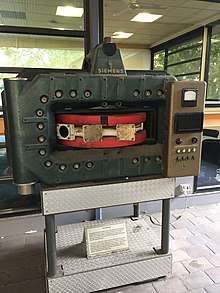Betatron
A betatron is a type of cyclic particle accelerator. It is essentially a transformer with a torus-shaped vacuum tube as its secondary coil. An alternating current in the primary coils accelerates electrons in the vacuum around a circular path. The betatron was the first machine capable of producing electron beams at energies higher than could be achieved with a simple electron gun.[1]

.jpg)

The betatron was developed in 1935 by Max Steenbeck in Germany to accelerate electrons,[2][3][4][5][6][7] but the concepts ultimately originate from Rolf Widerøe,[8][9] whose development of an induction accelerator failed due to the lack of transverse focusing.[10] Subsequent development occurred in the United States through Donald Kerst in the 1940s.[11][12][13]
Operation principle
In a betatron, the changing magnetic field from the primary coil accelerates electrons injected into the vacuum torus, causing them to circle around the torus in the same manner as current is induced in the secondary coil of a transformer (Faraday's Law).
The stable orbit for the electrons satisfies
where
- is the flux within the area enclosed by the electron orbit,
- is the radius of the electron orbit, and
- is the magnetic field at .
In other words, the magnetic field at the orbit must be half the average magnetic field over its circular cross section:
This condition is often called Widerøe's condition.[14]
Etymology
The name "betatron" (a reference to the beta particle, a fast electron) was chosen during a departmental contest. Other proposals were "rheotron", "induction accelerator", "induction electron accelerator",[15] and even "Außerordentlichehochgeschwindigkeitselektronenentwickelndesschwerarbeitsbeigollitron", a suggestion by a German associate, for "Hard working by golly machine for generating extraordinarily high velocity electrons"[16][17] or perhaps "Extraordinarily high velocity electron generator, high energy by golly-tron."[18]
Applications
Betatrons were historically employed in particle physics experiments to provide high-energy beams of electrons—up to about 300 MeV. If the electron beam is directed at a metal plate, the betatron can be used as a source of energetic x-rays, which may be used in industrial and medical applications (historically in radiation oncology). A small version of a betatron was also used to provide a source of hard X-rays (via deceleration of the electron beam in a target) for prompt initiation of some experimental nuclear weapons by means of photon-induced fission and photon-neutron reactions in the bomb core.[19][20][21]
The Radiation Center, the first private medical center to treat cancer patients with a betatron, was opened by Dr. O. Arthur Stiennon in a suburb of Madison, Wisconsin in the late 1950s.[22]
Limitations
The maximum energy that a betatron can impart is limited by the strength of the magnetic field due to the saturation of iron and by practical size of the magnet core. The next generation of accelerators, the synchrotrons, overcame these limitations.
References
- "Betatron | particle accelerator". Encyclopedia Britannica. Retrieved 2019-01-24.
- Pedro Waloschek: Rolf Wideröe über sich selbst: Leben und Werk eines Pioniers des Beschleunigerbaues und der Strahlentherapie. ///""Vieweg+Teubner , 1994, ISBN 978-3528065867, p. 68-69
- Wolfgang U. Eckart: 100 Jahre organisierte Krebsforschung. Georg Thieme Verlag , 2000, ISBN 978-3131056610, p. 140
- Harry Friedmann: Einführung in die Kernphysik Wiley-VCH Verlag , 2014, ISBN 978-3527412488, p. 357
- Vom Atom zur Kernenergie Walter Kaiser. Website of VDE Verband der Elektrotechnik Elektronik Informationstechnik e.V. 4. November 2015. Retrieved 2016-10-01.
- Sergei S. Molokov,R. Moreau,H. Keith Moffatt: Magnetohydrodynamics: Historical Evolution and Trends. Springer, 2007, ISBN 978-1841271729, p. 56
- "Physics and national socialism: an anthology of primary sources", Klaus Hentschel. Birkhäuser, 1996. ISBN 3-7643-5312-0, ISBN 978-3-7643-5312-4. p. 350.
- Wideröe, R. (17 Dec 1928). "Über ein neues Prinzip zur Herstellung hoher Spannungen". Archiv für Elektrotechnik (in German). 21 (4): 387–406. doi:10.1007/BF01656341.
- Dahl, F. (2002). From nuclear transmutation to nuclear fission, 1932-1939. CRC Press. ISBN 978-0-7503-0865-6.
- Hinterberger, Frank (2008). Physik der Teilchenbeschleuniger und Ionenoptik. Springer. doi:10.1007/978-3-540-75282-0. ISBN 978-3-540-75281-3.
- Kerst, D. W. (1940). "Acceleration of Electrons by Magnetic Induction". Physical Review. 58 (9): 841. Bibcode:1940PhRv...58..841K. doi:10.1103/PhysRev.58.841. S2CID 120616002.
- Kerst, D. W. (1941). "The Acceleration of Electrons by Magnetic Induction" (PDF). Physical Review. 60 (1): 47–53. Bibcode:1941PhRv...60...47K. doi:10.1103/PhysRev.60.47.
- Kerst, D. W.; Serber, R. (Jul 1941). "Electronic Orbits in the Induction Accelerator". Physical Review. 60 (1): 53–58. Bibcode:1941PhRv...60...53K. doi:10.1103/PhysRev.60.53.
- Wille, Klaus (2001). Particle Accelerator Physics: An Introduction. Oxford University Press. ISBN 978-0-19-850549-5.
- Science Service (1942). "Shall New Machine Be Named Betatron or Rheotron". The Chemistry Leaflet. 15 (7–12).
- Celia Elliot. "Physics in the 1940s: The Betatron". Physics Illinois: Time Capsules. Urbana-Champaign, IL: University of Illinois. Retrieved 13 April 2012.
- R.A. Kingery; R.D. Berg; E.H. Schillinger (1967). "Electrons in Orbit". Men and Ideas in Engineering: Twelve Histories from Illinois. Urbana, IL: University of Illinois Press. p. 68. ASIN B002V8WB8I.
- "The Biggest Betatron in the World". Life: 131. March 20, 1950.
- Big Science: The Growth of Large-Scale Research ISBN 978-0-8047-1879-0
- Nuclear Weapons Archive, Tumbler shot series, item George
- Nuclear Weapons Archive, Elements of Fission Weapon Design, section 4.1.8.2
- Wisconsin alumnus, Volume 58, Number 15 (July 25, 1957)